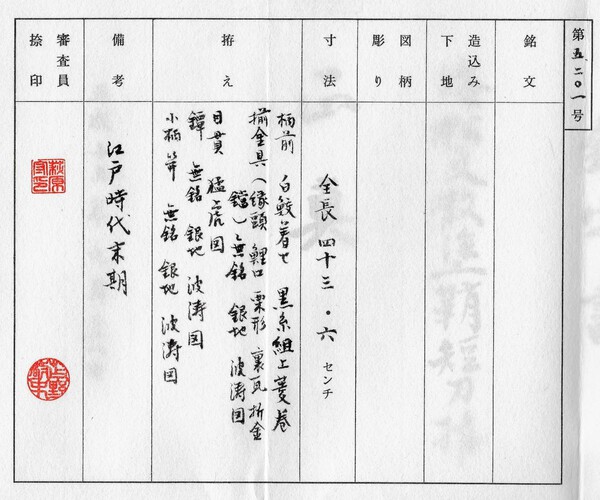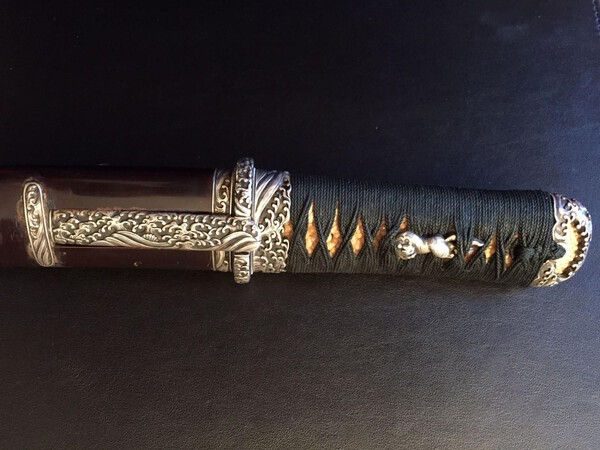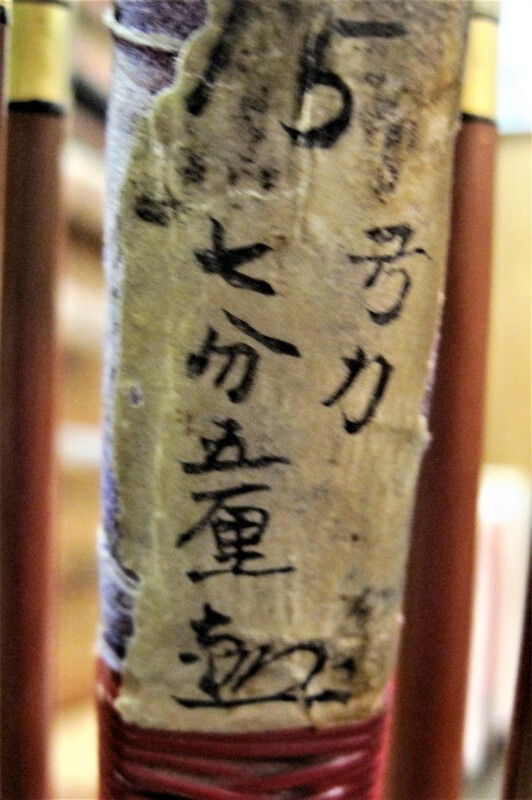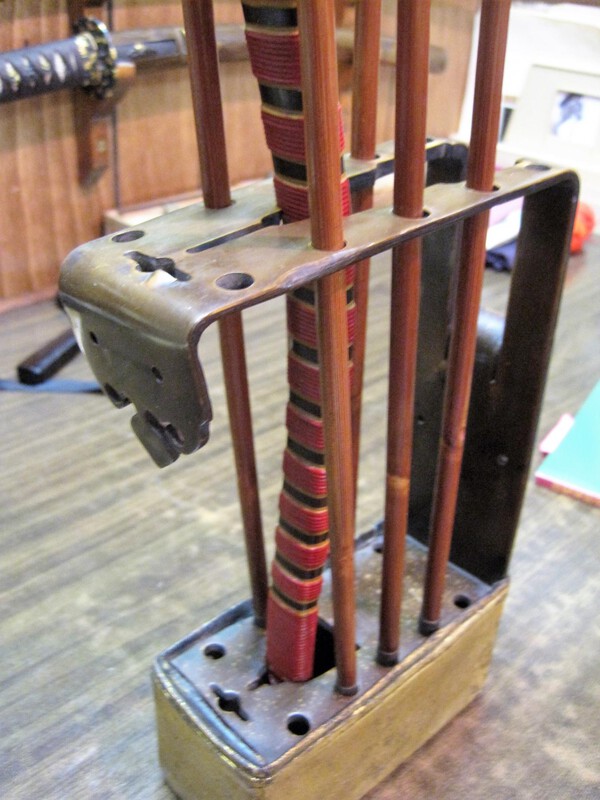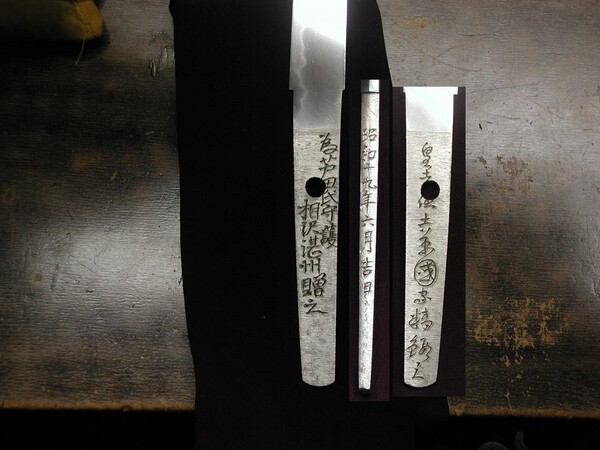-
Posts
703 -
Joined
-
Last visited
-
Days Won
4
Everything posted by Ron STL
-
Bruno, Kyo-Shoami would seem a good place to put this tsuba in my humble opinion. I would guess the tsuba is a good size (large)? Ron STL
-

Nagamaki Naoshi?
Ron STL replied to DaViebaPutkataMamina's topic in General Nihonto Related Discussion
Hi...if this would be an altered nagamaki, it does appear to have lots of "star-like" nie or ko-nie, which is good. Notice there is a kaeri which would indicate the blade shape has not been changed much. Just a thought from what can be seen of the jigane, sue-koto, perhaps Shitahara den comes to mind. Certainly nothing positive here at this point. Ron STL -
Hello Kirsty, Some interesting bits of advice here regarding your sword. Good to see you take some effort to confirm what your sword is all about. It is an amazing trip, learning what you can about Japanese swords! We all have our stories, good and bad. I met (via the mails, no internet back then) Bazza in those early years. We were both prolific letter writers, his mostly hand written, mine by manual typewriter. A very early purchase by me was an early 1600 wakizashi, Osaka area, signed Rai Kunimitsu. I was excited, but soon realized while quite old, it was not the signature of the famous Rai smith of 300 years earlier. Bazza and I learned a lot together although we never managed a visit, myself in St. Louis, Missouri and he in Melbourne. New friends were met and learning continued and continues today. I recall the final sword show in Birmingham, Alabama when some guy walked in with his newly purchased "garage sale" sword. I was the first to see it and was shocked to realize it was an ubu (unaltered), long signature Kamakura tachi! I alerted him to the importance of the sword, etc., etc. and in the end, he left with his wonderful tachi. Years later, early 2000's, he tapped me on the shoulder during a San Francisco show and informed me he took the advice and became a collector. His cheap garage sale find ended up achieving Juyo Token status, as it should had. I do wish I could remember the smith! Sorry if I've told this story before on NMB, but it's a good one with a good ending! Hope your new found interest sticks with you and you too can begin a wonderful adventure of your own. Ron STL
-
Thanks Mauro, that's what I was wondering about. Beautiful koshirae, beautiful tanto. Ron STL
-
Last January this tanto was a posted f/s item on NMB. The text describing the koshirae is well beyond my Japanese. I'm not expecting a full translation, but would love to see how the metal of the fittings is described. They appear to be silver, but this is what I'd like to verify or if not solid silver, what it is called. Motif is of course a waves design with dragon menuki. Work is unsigned and late Edo, but all quite beautiful. Thanks in advance...Ron STL
-
Thanks guys, all very interesting. Personally, I know very little about archery items. My friend wondered about this being for a wider arrow answer but now we know the whole story! The numbers referring to length and "pull" for the bow is also interesting. I'd never figured that one out! I'm sure my friend (Ted Kiss; usually at the Chicago show each year) will be searching for an shafted arrow of this type, so if anyone has one for sale I can forward this to him or show it to him in Chicago. Ron STL
-
Had some of the guys over Saturday and this bow/arrows set (I forget the name for this) was shared. The bow has this paper label attached to it but I could not make sense of it other than seeing the numbers 7 and 5 and a kakihan. If someone could translate this label to see what it says...wonderful. As an aside, we were wondering what was missing from the front of this mounting. It seems like perhaps a brace fit between the upper horn bracket and the base, but that is the question. Thanks! Ron STL
-
It would help if the nakago was shown vertical (reading top to bottom) so the kanji are right side up. Common problem with newer guys asking questions. We can of course fix this ourselves but...takes more time to do so. Just a suggestion. Ron STL
-
Ko-gatana looks to have a nice, healthy hamon. Wonder who "really" made it? Ron STL
-

What Is Your Favorite Hamon-Hada Combo And Why?
Ron STL replied to a topic in General Nihonto Related Discussion
So many beautiful groups of swords admire and enjoy, but I have always been taken (and learned from) the Awataguchi hada and hamon, Aoi works...but then a fine Hizen hada and suguha...well, what's not to be admired! While I prefer early swords and what you see in them, here I am admiring Naokatu/Naotane's works, too. My most favorite will still fall back to what you see in Awataguchi and most other Kamakura swords. Ron STL -
When reading the chapter on mumei swords my first thought was, "Well I guess I'll have set out my mumei Juyo Token Kamakura/Nambokucho swords out for the next trash collection (not)!" As has already pointed out there are mumei swords that are less desirable than others: mumei shishinto vs mumei Kamakura. swords. Just look at the swords that received Juyo rating (or Yushu rating) and notice the percentage of each as the swords move from Kamakura into shinto/shinshinto swords. I'm sure there are swords that were made suriage and only look like old koto examples, but all the more reason to study and learn to realize "quality" and what to look for. Certainly the book deals in "opinions" but also has good advice on that to look for so collectors will know what to and what not to see in honest mumei swords. Interesting topic to discuss and learn from. Ron STL
-
Thanks Steve, for the cleared up translation and link to the area. It makes me wonder who Major Sokabe Motoichi was. Franco, I'll see about getting a few relatively clear photos of the blade. I've had it for over 20 years but never tried to photograph the blade before. Good time to "sit with" the blade awhile and study it again. Ron STL
-
l'm not positive of the title -- Tensho Koshirae? -- a very large taikan size book on koshirae of that period. Sits with my books and something I should pay more attention to! Always advisable to be familiar with early koshirae and be aware of their importance. Ron STL
-
Years ago this handsome army D-guard, o-suriage mumei blade, attributed to Etchu no Kami Masatoshi, was purchased. I've always kept the surrender tag that came with it as part of the sword's history. The tag was translated by somebody way back then, but today, while updating the swords records, I would like to verify or more accurately understand the tag. The earlier translation was: SO KABE (or GABE MOTOICHI, HECHI KEN (NAGOYA) IMASEKI (town?) Nagoya Aichi-ken, Owari. I see some of those characters here, but not enough to convince me of the earlier wording. Anyone care to take a stab at this for me??? I recall being so surprised when the shinsa team attributed it to Masatoshi. The o-suriage,, three mekugi-ana sword looked late Nambokucho/early Muromachi to me. The was the 1997 NTHK shinsa in Long Island when senior Yoshikawa was head of the team, so I never doubted the teams call. In Keicho they were doing this copying older swords. Ron STL
-

General Development Collecting Nihonto/tosogu
Ron STL replied to BIG's topic in General Nihonto Related Discussion
Oh what fond memories, to reminisce about those "early days" of struggling to find information on swords/tosogu (pre-internet) and getting so very excited about learning your new find has some good qualities! It seems like nobody wants to get excited about the age and history behind these things we collect. Once you're deceased (a.k.a. dead) and your kids peddle off your collections for less than you paid for it, not a darned think you can do about it from "up there," or "down yonder." Just enjoy what you have and enjoy it when something wonderful finds it way into your hands. Think preservation. Rambling...but that happens a lot these days. RonSTL -
I'm not sure this is the Kuniie Ray mentioned, but this is the one in my collection. Terrific tanto, in my opinion. Nakago-mune shows the date of this special order tanto. I've also seen some nakago-mune signed by a polisher; that may have been on a sword dedicated to a shrine during celebration of there founding. Interesting sword that I handled decades ago but went elsewhere, to my regret. Ron STL
-
Being a devote reader of Albert Yamanaka's writtings "back then," somewhere in his newsletter he wrote about the oddly shapped mekugi-ana. Not sure if he suggested why they were made like that but he did write it was often used on Rai School swords (and perhaps other schools of that period). For that reason, I've always watched for such ana on promising "old" swords. I've also see this on much newer swords but they just look "not right" and simply reminiscent of the Kamakura masters. Interesting topic. I need to read what Marcus wrote... Ron STL
-
Thanks everyone for your input on this tsuba and the filling material used on it. I'm sure the motif is as everyone says, "pine tree." Maybe with a little more looking around the work can be placed to a group but if not "textbook" work, that can be at best a good guess. It is interesting to think about the fill used for the tree trunk. First impression seemed it was obviously lead; you see lead used on many of shinshinto Naokatsu's works. But I'll go take a closer look at the filling with a loop. I do recall seeing a "hint" of color existing at the very bottoms of the punches, but passed it off and something not really there. With our icey weather past here in St. Louis, there is a good chance one of my sword buds who has a degree in metals may venture up for a visit. If so, I'll see what he "sees" when study this material. I'll keep the topic updated. Ron STL
-
Memories of days gone bye. When I joined the JSS/US in the late 1960s, Nakajima was actively working with the JSS/US as polisher/restorer. If I recall correctly, I was able to have two swords -- a tanto Mino Kanemasu and a wakizashi, a joint effort by Masanori and I believe Masakatsu. The tanto was eventually published in Benson's publications as "Tanto of the Month." The Masanori was found to be in Fujishiro Shintohen, p. 309. Unfortunately, a hagiri was discovered on the blade during finishing steps which frustrated Nakajima. The polish was completed by my request and I believe still resides in a Texas collection, today. Wearing many hats for the JSS/US over the years, I believe the "books," the records of blades polished by Nakajima and costs, etc., is still around here somewhere. A katana polish costs around under $50 back in the 1960s! Amazing. I still get a kick out of listening to stories about Nakajima, told by the "youngsters" he welcomed into his workshop...Rick Mantegani, Steve Crotty and others who today, can't be called "youngsters" anymore. I wish I was living in San Francisco in those early days! Ron STL
- 1 reply
-
- 3
-

-
Looking for some ideas as to what is being depicted on this tsuba. The design is negative sukashi with a portion of it being filled with what looks like lead. The two hitsuana are also filled with lead. The lead punched with random and somewhat bold design (like nanako, but not). On the omote side, this lead filled design appears with a rock in low relief at its base. On the ura side, there is no rock. I've been studying the design and can possibly see the depicting pine trees with the filled sukashi being a tree trunk. Not sure about this since I've never see pine trees (often "distant pine trees") made in this manner. The lead fill is rather interestingly made, what with the punched design cover its surface. Tsuba is of iron and is large and thick, 81 mm x 83 mm x 6 mm at the edge. The plate surface is slightly sunken, measuring ~ 5.5 mm thickness. The plate surface is covered with the hammer marks you see (not rust pitting, as it might appear on the photos). Any ideas??? Ron STL
-
Marc, it is possible the Hisakuni Jim wrote an article on was the one in my collection, Juyo Bitjutsuhen designated. Are you seeking a photo of the nakago or the entire blade? A number of articles have been written about the Hisakuni over the years. The tachi John attached photos of are known example in many books. The first example is the only Kokuho, the others are JuBi level. I believe there are seven known "signed" Hisakuni known. Ron STL
-
That's an interesting thought, James.
-
Any more thoughts on why this "motte ko nabe tetsu saku kore" statement is placed where it is, on the area that would had been the surface of the blade prior to suriage??? Ron STL
-
Very interesting and strange, too, since this is carved above the newer mekugi ana on the surface that was part of the blade before suriage. I'll see if I can find this inscription on Marcus' site. It's no wonder this stumped me! Looking around for examples of Mitsuyo's work, I found one example in Art and the Sword, Vol. 2, p.44 (article on Owari), and in Fujishiro Shintohen p.419. Later I found several examples in Shinto Taikan p.723. Another thing I found interesting, Yoshikawa calls the smith Mitsushiro whereas Fujishiro (translation) calls him Mitsuyo. Any idea why this is? Ron STL
-
At our sword meeting Saturday, I was curious about this nakago inscription on a suriage katana by Higo no Kame Hata Mitsuyo. On the nakago ura it reads that the sword was suriage (shortened) by Owari Nobutaka. There is a date of Kyoho 2 (1717). The upper inscription puzzles me. I see tetsu saku koreo, but I can not understand the kanji before this. I'd appreciate a character x character reading and meaning of this please. Mitsuyo worked in Owari around ca.1673 so I can see Nobutaka being there to suriage the sword, but the date on the nakago seems to possibly be the date of suriage and not when the sword was forged. This is a well made sword although Mitsuyo is rated "chu jo saku" by Fujishiro. It's not my sword, but I think the nakago inscriptions are interesting and need to be fully understood. Translation and any comments, appreciated. RON STL


